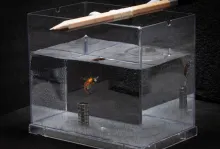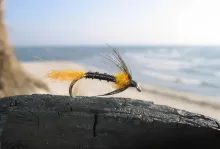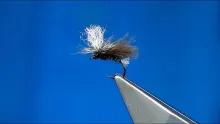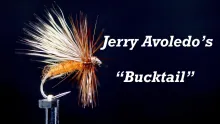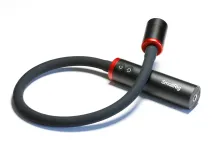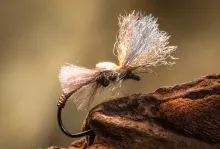Getting a decent macro image of a dry fly sitting on water is one of the hardest shots to pull off
As someone who takes a lot of pictures of flies, I can say with confidence that getting a decent macro image of a dry fly sitting on water is one of the hardest shots to pull off. The trouble is the little buggers just want to move. The slightest draft or vibration, or even breathing too close, will cause them to sail off across the water. With a very small field of view framing and focussing can be nigh on impossible. Combine that with the long shutter speeds required with a macro lens stopped down to a small aperture inevitably results in blurred images. You could use flash to freeze the movement, but you’d still have to compose and focus with a very small depth of field on a subject that can cross the frame in seconds.
The solution turned out to be something I had used before; tiny, rare-earth magnets. They are useful in a range of fly photography applications like holding a fly upright on a sheet of white or black Perspex or balancing it on the rim of a fly reel. These methods are described in my book Imaging Imitations. I also use a stack of magnets stuck to the bottom of a small plastic tank to photograph flies underwater. The pull of the magnets holds the fly in position tensioned against a length of tippet attached to a pencil on top of the tank.
I figured I would need a shallow steel tray to hold enough water to float flies in a range of sizes and big enough that the edges would not show in the image when shot at a low angle. The steel would allow me to attach and hide magnets underneath the tray to hold the fly still.
I took a magnet for a trip to the kitchenware section of Cardiff IKEA. You get the odd funny look as you wander around picking up trays and dishes and testing them to see if a magnet sticks. In the end I settled on an Inbakad 22cm pie dish which cost me just £2. It’s a mid-greyish colour which doesn’t clash with the colours in a fly and makes for easy exposure metering.
I put three 10x3mm circular magnets around the edge to act as feet and lift the dish up to allow placing a group of 3x1mm magnets in the centre to provide the magnetic field to hold a floating fly still. You want enough magnetic force to hold the fly in position but not too much, otherwise the magnet will pull the fly down. Adjust the number of small magnets to suit the buoyancy of the fly and the depth of the water.
You need to have enough water in the tray to prevent the fly running aground. The Bibio pomonae heather fly imitation shown in the images is tied on a size 14 long shank jig hook which has a 6mm gape and was photographed in around 15mm of water. An Inbakad tray is around 3cm deep so you can float much bigger flies if you need to.
Once you get it right the fly will stay still while you move or rotate the dish to frame up the image or you can gently nudge the fly into the desired position and angle with a pencil or a small paintbrush.
Photographing dry flies attached to a length of tippet is a bit more difficult as any tension, spring or twist in the tippet will cause the fly to move. These forces are best minimised by not anchoring the end of the tippet, just drape it over the edge of the dish and allow the fly to settle in place.
Some fine tuning of the water level and/or the number of magnets under the dish may be required to counteract any remaining influence of the tippet. I use a plastic pipette to add or remove small volumes of water and a paintbrush to steer the fly into a position where it sits still.
Hand picked for this article
- Log in to post comments









